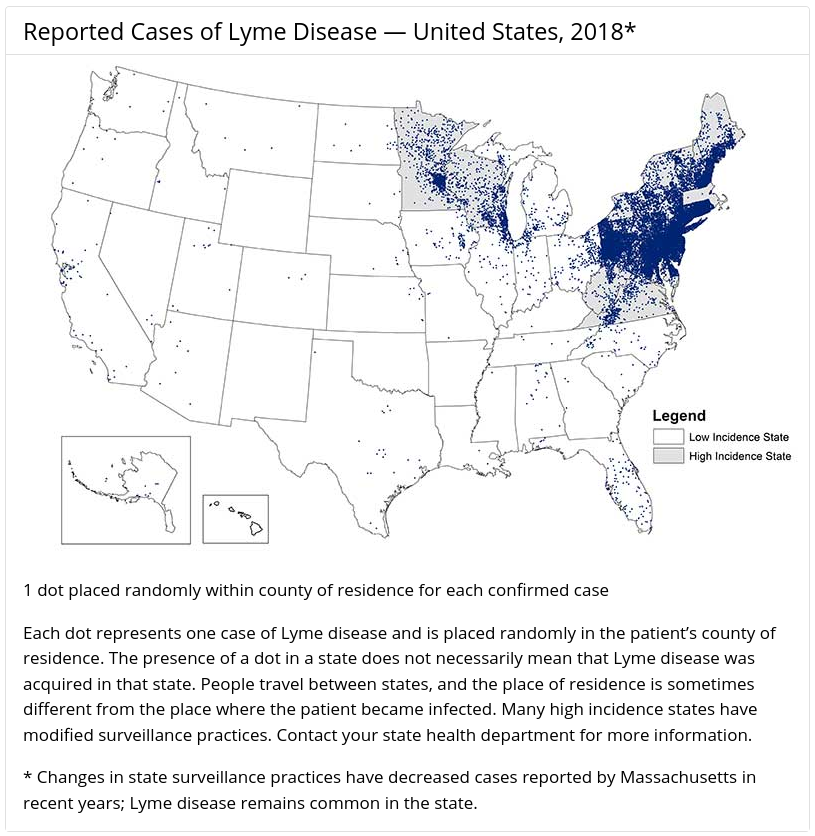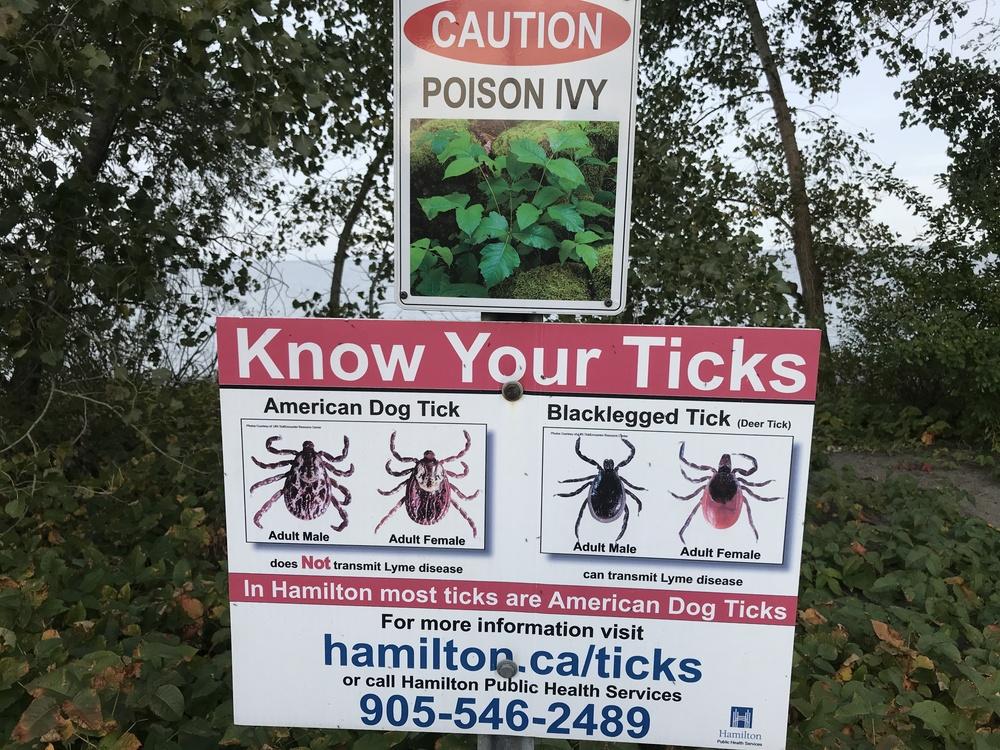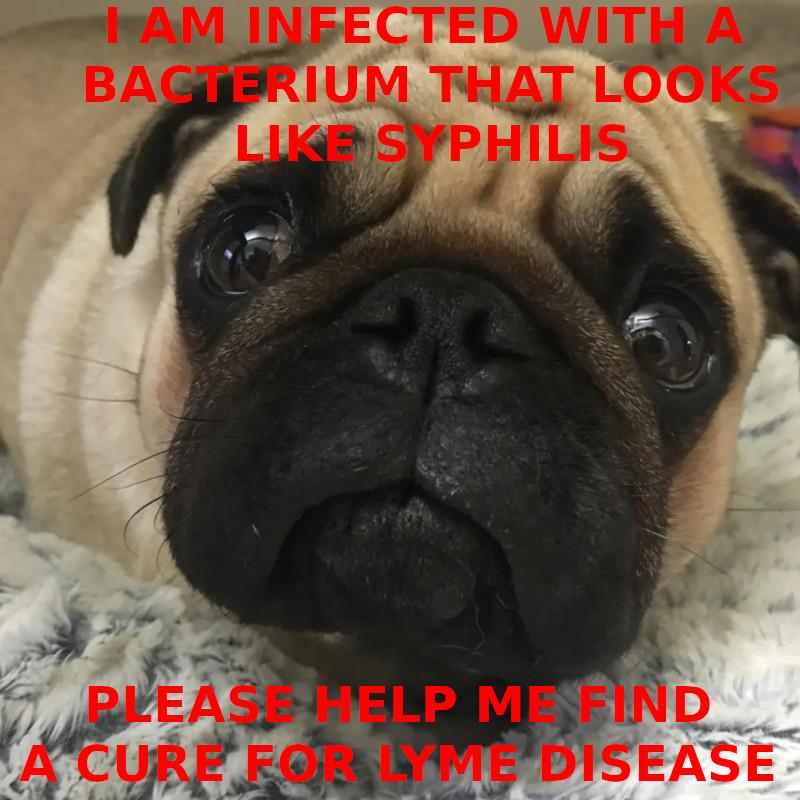Review: Lyme
:date: 2021-08-20 23:13 :tags:
I heard about this 2018 book by Mary Beth Pfeiffer and thought that Lyme disease was something I probably should know quite a bit about. I clearly remember on a trip in 2001 worrying about some friends who liked to sleep with their tent unzipped. Twenty years ago I thought that was incredibly risky specifically because of Lyme disease. This is not a new topic for me.
And despite my constant vigilance to specifically avoid this unsettling affliction, I was one of the lucky people to get the runner up prize of Long Term Covid blah blah whatever. I call it The Plague Ghost because, as we'll see with Lyme disease, health authorities aren't very good about pathogens that do subtle hard-to-measure long term damage. Since The Plague Ghost and Lyme disease share many striking similarities it might be a good idea to have a closer look at what exactly is going on with Lyme and just how badly health authorities have historically bungled that one too.
I have to say that I can't really recommend reading this book to people who don't care a lot about this topic in some personal way. It is filled with writing like this (p249): "Under the program, cattle are regularly rounded up, sometimes by helicopter, inspected, vaccinated, and periodically dipped into treatment baths for six to nine months." Yes, a real sentence from the book. But I tried to look past that and credit the author with doing her best to tame a very messy topic that nobody has really succeeded in taming.
The first thing to note about a book like this if you're a publisher is that it will be a certain money maker. How do you know it will sell a ton of copies? Because there really do seem to be tons of people out there suffering something serious which the CDC is kind of in denial about. If people think they have Lyme disease, they'll buy books like this.
That said, when I read the following sentence, I couldn't help but smile (p4): "And yet, some 10 to 20 percent of people infected annually with Lyme disease, estimated at 380,000 Americans in 2015, have symptoms that linger months and sometimes years after treatment." Whew! Only years? That's a relief! So it does end, eh? Good to hear! Of course maybe people drop dead from it after a couple of years. But no, dropping dead doesn't seem to be typical.

(The first thing this map makes me want to do is know exactly WTF MA is up to. The second thing is it makes me want stand outside of CDC headquarters holding a large sign that says "Base Rates!" while screaming the same.)
That's 380,000 "cases" or "infections" or something. But just in case you missed the 380,000 number here it is again on p63 where we're told that the CDC admits that "10 to 20 percent of people who were treated for Lyme disease 'will have lingering symptoms of fatigue, pain or joint and muscle aches,' sometimes 'for more than 6 months.' That amounted to 38,000 to 76000 posttreatment sufferers of the 380,000 Americans estimated to to be infected in 2015 alone." So right away we have to wonder about just how this was "estimated" given the book goes on at length to talk about how inaccurate "tests" are. Reminds me a lot of another recent plague's Numberwang.
I just noticed that the CDC's web page where I got that map is saying, "approximately 476,000 Americans are diagnosed and treated for Lyme disease" per year. Treated, not cured. For how many did the treatment fail? And how many people didn't realize the infection was Lyme disease and are being told they're mentally ill for being in pain and tired all the time?
So how does this disease work? Well, the most important fact to know is that it is complicated. Super duper complicated. But I'll quickly review the current thinking on the topic or at least the impression of it that I was left with. Step one is that some ticks are born and fall to the ground. These larval ticks hang around the great outdoors waiting for a juicy blood filled animal, most commonly a mouse. Mice are very important to the whole process. They seem mostly not terribly bothered by the ticks or their diseases and are hosts for many of the bacterial pathogens that cause problems. Ticks have all kinds of great stuff in their saliva — anti-coagulants and, importantly, anesthetics so the host feels nothing. These larval ticks start feeding on the host's blood and it is at this time the hosts usually pick up the real villain here, Borrelia burgdorferi, the bacterium that causes Lyme disease.
It was interesting to learn about larval ticks. These are so small that seeing them (especially if your eyesight is as good as mine) is practically impossible. The good news is that these will, generally, not have been riding on a mouse if they are riding on you. This means that they will generally not have picked up (as far as we know) Borrelia burgdorferi which causes Lyme disease. But the book hints that there is another pathogen called Borrelia miyamotoi which can be given to newly born ticks directly from their infected mother. The odds of that problem seem like they are much smaller than Lyme itself but it's all rather murky.
Once the baby tick gets its first blood meal, and quite possibly a sub-parasitic infection of Borrelia, it then drops off the host and grows a bit into the next stage. There are a zillion kinds of ticks and it's all very complicated, but the main one in this story is Ixodes Scapularis also known as the "deer tick" or "black-legged tick". This one likes to climb up stalks of grass. That's really its one tick trick. It sits there very patiently on its grass stalk waiting for a big blood filled animal to walk by, like a deer, or us.

When it senses CO2 and/or motion it can grab onto the passing host. It is when this stage of the tick feeds that the Borrelia bacteria can sense the opportunity and actively swim against this feeding stream and into the (next) host's body. A very important thing to note here is that this is not a cobra strike — this does not happen instantly. It may take up to 30 hours for the tick to pass a problematic amount of bacteria to the host. I got the feeling that if you can spot and remove a tick before you go to bed on the day you picked it up, you'll probably be ok. Let's just say that the odds of avoiding a serious infection are greatly reduced. The sooner you get the little buggers off, the better.
It is on this host — often a deer but lots of other possibilities exist — that the ticks find their mate, reproduce, and have the babies that start the process anew.

We humans are mostly concerned with our part of the life cycle. Let's say you find a tick on you, what do you do? There are folk practices for removing ticks that seem questionable. Stuff like holding a match to them and covering them in grease, etc. The book didn't go into serious detail, but it seems the correct way to handle it is with tweezers. It is important not to simply squeeze the contents of the tick into your open wound. You want to grab it gently as close to the skin connection as possible and carefully lift it out. It is definitely advisable to carry tweezers in your hiking kit (Swiss Army knives often have them). It was suggested that two credit cards can also do the trick if you don't have tweezers.
Great. You've managed to get the little fucker off of you. Now what? My personal recommendation if you have a handy ziploc bag or piece of tape is to save the thing; it might be valuable evidence later.
It seems like in most cases, that's that. You're fine. Have a nice day. But this wouldn't be a big deal topic if there weren't a pretty serious number of pretty serious exceptions. If you get infected by the Borrelia burgdorferi bacterium it is common, though the book stresses not assured, that you will develop a "bullseye" rash around the bite site. This is a critical piece of evidence used in diagnostics. If you have this rash and your skin is pasty white enough to see it (yes, it can be practically invisible on darker people) then doctors seem to have permission to not treat you like you're just making shit up. If you don't have the rash — which apparently is very common even when infected — you'll want to start preparing yourself for the the medical profession to be complete assholes. I'm not quoting the book verbatim there but that was kind of the message.
But surely there's "a test"! Yes. The next step if you've been bitten by a tick or if the doctor thinks you're talking Lyme jive after reading too much nonsense on the internet, is that you'll get an antibody test. This tests for antibodies that your body would be well-advised to produce if there's some Borrelia crashing your party.
I know this will come as a shock to everyone who has just witnessed the global clusterfuck that has been our species' response to our current Covid19 Plague, but it turns out that testing for Lyme disease using these antibody tests is not accurate. In fact, the case seemed pretty well made that these tests are wildly inaccurate. Hopefully you were preparing for your doctor(s) to start being complete assholes, because once this deeply flawed test comes back negative, they will assume you're some kind of annoying malingerer. They will literally diagnose you with having read too much about Lyme disease on the internet. So it seems very important to keep your fingers crossed when that test goes out.
But wait, surely if the test comes back "negative" you truly do not have "it". Well, no. Wrong. It means you don't have antibodies to a specific form of "it". Those antibodies get produced in differing amounts at different times and it's all very complex. And some people are very close to the cut off but not quite over it. Or they have a lot of one antibody and not much of another. Stuff like that.
In fact the whole premise of testing is deeply flawed. For example, (p115) "...studies that measure the accuracy of Lyme disease tests should be viewed skeptically. Some rely on a kind of circular logic, selecting patients on which to validate the tests who have been known to suffer Lyme disease — precisely because they had already tested positive in two tiered [antibody] testing."
And there's a huge messy topic of other Borrelia species and other tick-borne infectious pathogens like Rocky Mountain Spotted Fever, Babesiosis, Powassan... oh god, the list just goes on and on. But if your simpleton doctor doesn't see the one unreliable simple test come back "positive", consider your much worse treatment to be another bad luck part of the disease. (This is why I avoid ticks and doctors equally.)
If you are lucky enough to have the rash (recently, especially if the doctor sees it) and/or the test comes back positive, and you catch the infection early, it does seem that normal antibiotics will very often completely preclude any further serious problems. What's funny is that if you don't get it in time or your doctor doesn't believe you have a tick borne illness (even though you know you were bitten by 100 ticks last week) you get sent to the insane asylum if you complain of Lyme's other symptoms. It's funny because why bother treating the positive case with antibiotics if missed cases are of negligible importance? Best not to delve into the logic much here.
What exactly are people complaining about who think they have a tick borne illness? Here's the CDC's official list. A lot of joint pain/swelling and arthritis, also muscle and tendon pain. Also weird shit like facial palsy, numbness, other strange rashes. Strangely that CDC list of long term symptoms does not include one that was prominent, almost central, in most of the specific patients the book profiled: fatigue. It is included in early symptoms (barely) but it was pretty clear that for some people, this disease could wipe a person out pretty much forever. I even just quoted (from p62) a passage where the book quotes from the CDC specifically saying, "...lingering symptoms of fatigue...". So why it's not on the list of of long term symptoms is... well, the whole point of this book. Something weird and not terribly helpful does seem to be going on over at the CDC with respect to Lyme disease.
So that's Lyme disease. What do we do about it? Antibiotics given promptly seem to be very effective. The problem seems to be that because of this, the CDC (and therefore all the doctors of the world - not exaggerating) does not believe that Lyme disease is serious. It's either treated or it's not a thing. Yet for a lot of people it really does seem to be A Serious Thing. And very often these people who were clearly, obviously, not malingerers before getting bitten by a tick now have their lives completely destroyed. It does seem that even in 2018 the CDC was being obtuse, or at least generating controversy, about a pandemic it had more than two decades to think about.
At that point in the story I totally sympathize with the victims. They get a very shitty disease and the deal is made worse by the awful victim blaming from the medical community. I totally understand how uncool that is. But there was a point where I parted with the author a bit even though we both thought the situation was obvious. She thought that it was reasonable to give these long term sufferers a lot of antibiotics. While I, on the other hand, am not one bit afraid to say, it sure sounds like we simply have no fucking idea what to do for these people.
The gist of the book's rant (p38): "Yet while the risks of prolonged antibiotics are common to and acceptable for conditions such as acne, urinary tract infection, or tuberculosis, a line has been arbitrarily drawn on Lyme disease. And it is based on medical recommendations that have been raised to the level of dogma." Could be. Or maybe the antibiotics are straws being grasped at. I was impressed to hear of some restraint somewhere in the medical world with respect to profligate antibiotic overuse. But I would not be a bit surprised if they traded their typical type I error for a type II error here.
This quote (p172) summarizes the theme, "It isn't just that doctors do not know what to do in complicated cases, although they don't. The bigger problem is they have been told there is no problem at all."
The author goes on to describe (p66), "a medical landscape that is breathtakingly controversial, and in many ways, dysfunctional, one characterized less by warring sides than by parallel universes. The side taken by the CDC strenuously and dogmatically proffers a view of the disease that is straightforward and unambiguous, solidified in 2001 by two major treatment trials and precious few since. The other sees a disease complicated by poor tests, a bafflingly complex and crafty bacterium, and the influence of related tick-borne infections, like babesiosis and bartonellosis, and a variety of related B. burgdorferi species and strains that may be missed by classic tests. Often denied government grants, this side has conducted research experiments with the help of nonprofit entities, challenging the status quo."
Apparently the CDC gave out $2.7million "in Lyme grants in 2016" (p228). The book doesn't really mention what our baseline expectations should be. What other diseases are getting funded and by how much? Maybe it is the majority of the CDC's funds for such work and it's the NIH or NSF doing the majority of the funding. Though my firsthand observations when I was paid from NIH grants make it easy to believe the funding strategies are suboptimal.
I'm kind of annoyed with annoying subtitles on books like this and this one was especially annoying; the full title was: "Lyme: The First Epidemic Of Climate Change". So what about that climate change stuff? (p21) "It is an illness spread by ticks, the EPA report states, whose 'populations are influenced by many factors, including climate.'" That about sums up... well, every living thing on our planet! Really I could not find any substantive or interesting theme about climate change that could reliably be correlated to public health with respect to tick borne illnesses. Yes, ticks can now go to where it was once too cold. But presumably, they are now banned from where it was once just barely not too hot. I'm sure something is going on, but this book doesn't really properly explore what.
I think the most interesting thing I got from this book was another off topic digression. I've been thinking about the Plague Ghost, obviously, and I've tried to think of all the possible mechanisms that could be involved. Here are my three main hypotheses for the cause of long term Covid troubles.
1. Covid destroys its host's body leaving the victim with damage that takes a long time to repair or even maimed for life. 2. Covid is not completely defeated by the immune system and lurks in hard to reach places flaring up occasionally to cause mischief. Other viruses that hide in a dormant state are hepatitis and herpes; so this is not unheard of. 3. Covid traumatizes the immune system so badly in the course of fighting the infection that the immune responses are tuned too aggressively producing subsequent overzealous reactions to benign biological structures.
Got all that? Well, the book tipped me off to another possibility which is kind of like all of the above combined. Check out this experiment: (p138) "...something lingered in the joints and surrounding tissue of diseased mice that had been given antibiotics. ...but they were not viable, infectious organisms of the kind that lived in the mice before treatment. [The researchers] found a kind of debris, seen in fluorescent deposits near ear cartilage and within joint tissue of mice, which contained the spirochete protein. That detritus was enough... to cause 'prolonged inflammatory responses in the joint after infectious spirochetes have been eradicated'." Note that the spirochetes are the distinctive helical tails that help the Borrelia swim out of the ticks.
The idea is that maybe the virus is defeated, but its envelope or spike protein or whatever — some other metabolic junk related to it — lingers on. This wreckage is not active, but sometimes the immune system sees it and "shoots at the corpse" just for good measure. That's all wild speculation, but I appreciate that since it beats what else we have to go on.
Lyme disease is an important topic. If you're quite interested in it, then I recommend this article in Outside magazine which is probably a better use of most people's time than the book. The Wikipedia article on Tick-borne disease is also a surprisingly quick read and answers immediate practical questions about as well as the book does.
And finally, I'd like to offer the cure for Lyme disease. Yup. We could put it behind us completely in a matter of months. Here's how. Advocates for Lyme disease research must portray it as negatively affecting the quality of life of adorable puppies. Those ticks do love dogs! Who cares about the neighbors? And especially their bratty kids? Better if they did stay indoors 24/7! But if you feature adorable innocent dogs getting "infected" by this malevolent pathogen, well, just watch the funding pour in! You're welcome. Hopefully some of that research will apply to the Plague Ghost too.

UPDATE 2021-08-21 - So what's the latest Lyme disease news in 2021? This article in The New Yorker. Was published while I was writing mine. It's full of interesting facts and news about the latest efforts to create a Lyme disease vaccine. Worth a look.
UPDATE 2021-09-25 - Dr. Bruce Patterson seems to be doing some of the most sensible thinking I've yet seen on long haul covid. This video is a few months old, but he affirms exactly what I said about the lingering "pathogen trash" hypothesis being interesting in Lyme and Covid long haul.